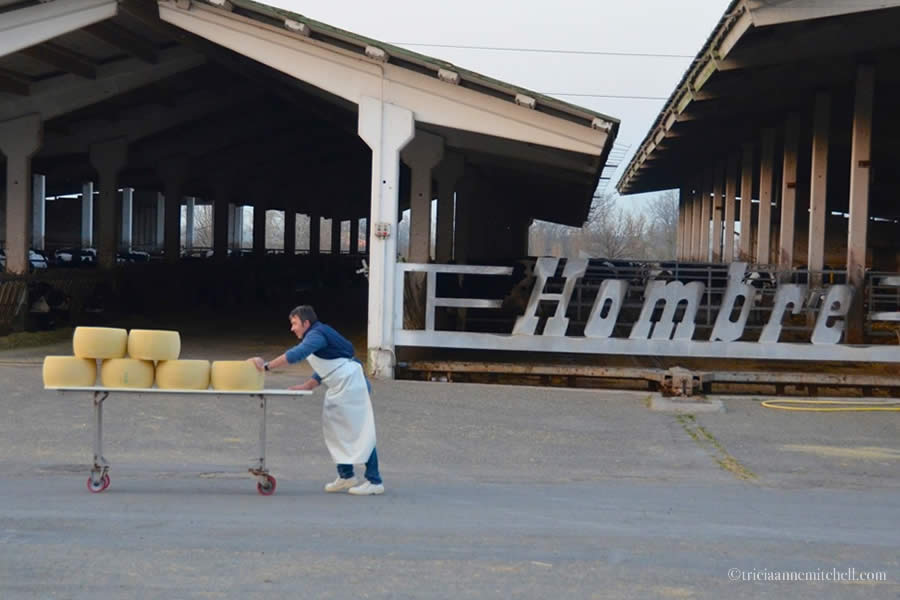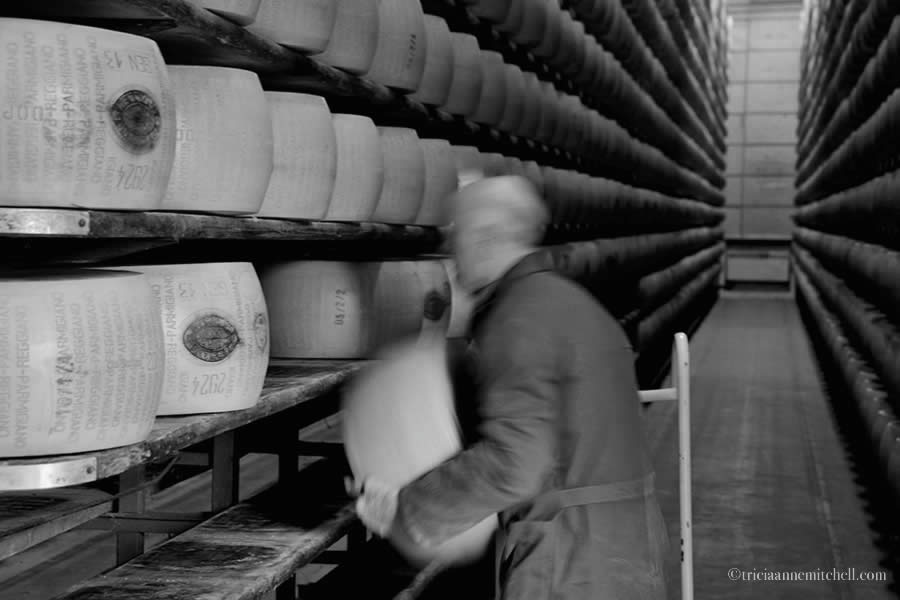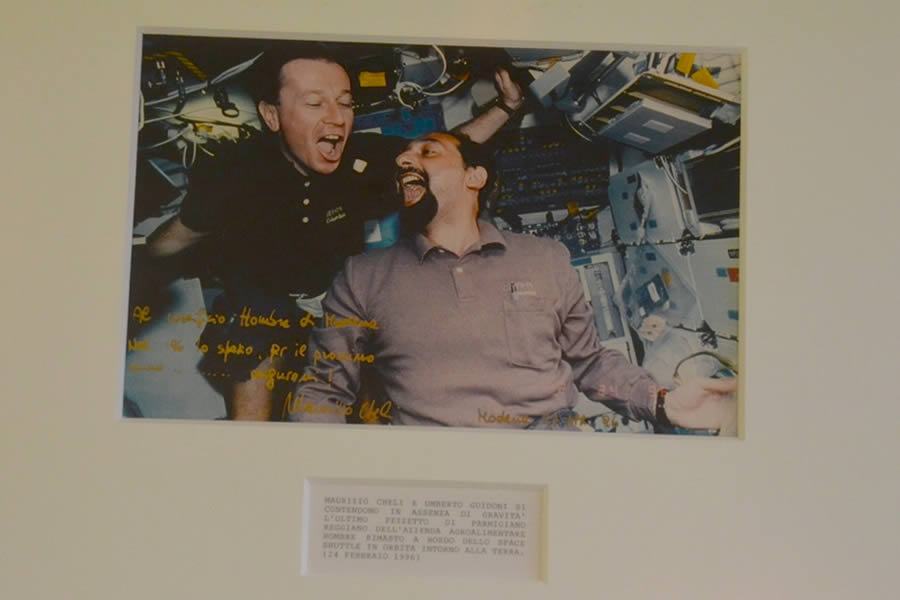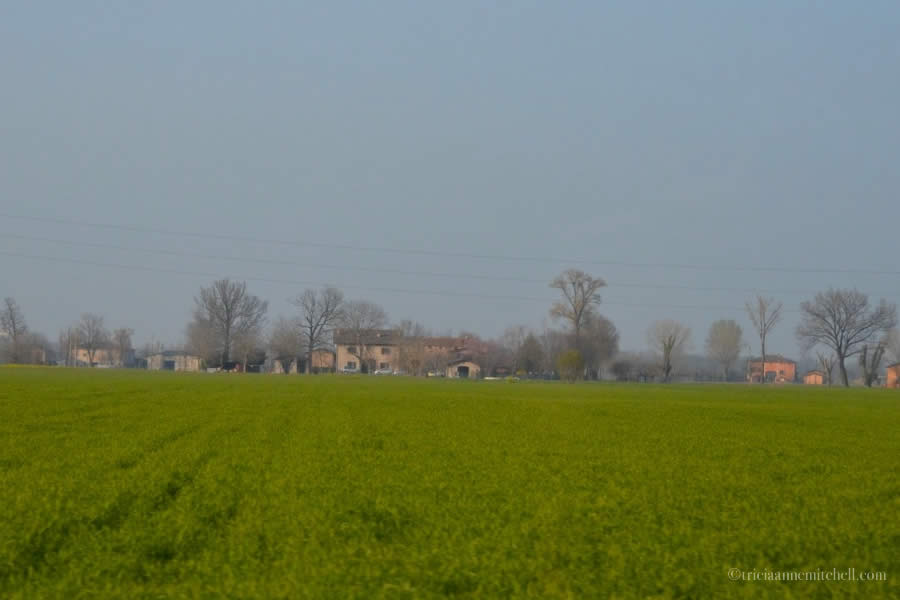Modena cheese maker Carlo has been producing Parmigiano-Reggiano for more than 50 years. Still, the farmer-turned-cheesemaker does not tire of the prized Italian cheese.
“I always have Parmigiano-Reggiano in my mouth (when not at work). I constantly keep eating it,” he joked, as we toured the Hombre Organic Cheese Farm in Italy’s Emilia-Romagna region, just outside of Modena. The opportunity to learn about another Modena prized delicacy, traditional balsamic vinegar, would be next our next stop.
As Carlo inspected and cleaned a wheel of cheese weighing approximately 38 kilograms (or 80+ pounds), he noted that his other culinary weaknesses were spaghetti and bread, but that as he’s gotten older he’s had to cut back from eating as much as 1 kilo (or 2.2 pounds) of bread a day!
He then loaded up a dolly with several massive wheels, walking into the nearby storage room to place them on a shelf for aging.
Our guide, Elena, chimed in. “After 24 months of aging, the cheese’s flavor is rather mild. Even if it’s aged 40 months, the flavor is not too sharp or overpowering. There’s a belief that the American market wants sharp flavor, but the Italians prefer the flavor not so sharp,” Elena added.
Next, we toured the grounds, seeing a sampling of the pampered Fresian cows that produce the milk for the cheese.
“Hombre’s cows are well taken care of. One can’t push production – the cows must be allowed rest time. They listen to classical music in the milking room, and no humans are allowed there to help ensure the cows do not become stressed,” said Elena.
Before proceeding to the farm’s shop for a tasting session, we explored the gallery of classic automobiles collected by the farm’s late owner. Masseratis, Mercedes, and Cadillacs were on display, shimmering in the late afternoon sunlight of the golden hour.
Inside the tasting room, we regretted that we didn’t have a large piece of luggage in which to carry home a wheel of the cheese, for the mouthwatering morsels awakened the turophile in both of us. Neither one of us felt shameful about taking the last piece on the plate, known in Italian as the vergogna, or ‘The Shame.’
“Hombre’s cows are well taken care of. One can’t push production – the cows must be allowed rest time. They listen to classical music in the milking room, and no humans are allowed there to help ensure the cows do not become stressed.”
– Elena
Bidding farewell to the cheese paradise that is Hombre, we were whisked off to the Società Agricola Acetomodena, to meet the traditional balsamic vinegar producer whose family has been making the so-called ‘black gold’ for more than 100 years.
Riding through Emilia-Romagna’s spring-green countryside, Elena shared some tidbits about the culture surrounding the region’s esteemed product.
“It’s customary for balsamic vinegar-producing friends to give vinegar to their family members and friends for Christmas. And we put it on frittatas, pumpkin and potato soup, salads, boiled potatoes, risotto, even strawberries or gelato,” she added.
Contrary to our expectations that the producer’s acetaia would be housed in a centuries-old building, the Società Agricola Acetomodena structure was streamlined and modern, with a panoramic tasting room that overlooked the rows of Lambrusco and Trebbiano grapes that are harvested for the vinegar’s production. Bubbly owner, Patrizia Marchi, along with employee, Gary, greeted us and explained the process.
“Once the grapes are harvested, the grapes are pressed and cooked into a must, or a juice,” they explained. “After a long period of fermentation and aging in a series of barrels known as a battery, the liquid becomes balsamic vinegar of Modena.”
Like Matrioshka nesting dolls, the battery consists of barrels that decrease in size, with the must starting out in the largest barrels, and graduating to the smaller ones.
Having heard that a battery is started to commemorate the birth of a son, we asked Patty if her family had followed this tradition. With a warm smile, she guided us over to a series of barrels near the sleek glass partition, indicating that they were her son’s.
In order to attain DOP certification, the vinegar must age at least 12 years, and to be declared Extravecchio, – literally ‘extra old’ – at least 25 years. During the process it’s regularly tested and must be approved by official tasters. It can only be designated Aceto Balsamico Tradizionale di Modena DOP if it has gone through this rigorous process. It’s then bottled in a uniform bottle called a cruet, which is numbered with a seal.
On an antique horse-stall door-turned-tabletop, we sampled from several bottles, ranging from the more humble condiment to the ‘grandfather’ bottle that had been aged for 25 years. It had no bite, and was especially smooth.
“Life centers around the table here,” Gary said. “Every family has balsamic vinegar on their table.”
The next afternoon, we enjoyed a treat of plump strawberries dotted with balsamic vinegar from the Società Agricola Acetomodena. Upon tasting it, we could see why every family is passionate about their balsamic vinegar, for it took the already-divine strawberries to a new level.

























Our Video of This Experience:
Where in the World?
Further Resources:
- Italy’s Practically Perfect Food (BBC Travel)
Planning Pointers:
- The Hombre Organic Cheese Farm is located at Via Corletto sud, 320, 41100 Modena, Italy.
- The Società Agricola Acetomodena‘s address is Stabilimento in Strada Borelle 120, 41126, Modena, Italy.
- While in Modena, we spent 3 nights at the elegant, historic, and centrally-located Hotel Canalgrande (affiliate link). One of our favorite memories from Modena, in fact, was sitting out on our hotel room balcony just before sunset, looking out over Modena’s rooftops, while enjoying goodies that we’d procured at the Albinelli Market earlier in the day.
- Peruse the Emilia-Romagna Tourist Board website for more details about this region’s rich offerings. Also, they’ve just recently released a free e-book that chronicles Emilia-Romagna’s Art Cities. I wish it’d been published when we were in the region, yet it’s since presented even more excuses to return to this stunning part of Italy.
- If you’d also like to “eat, feel and live local in Italy” as we did in Modena, check out the BlogVille project website.
- Need more inspiration? This link contains an index of all my posts from Italy.
Disclosure & Thanks:
Our Modena visit was supported by the Emilia-Romagna Tourist Board, to which we extend thanks.
An extra special thank you to Nick and Francesca for coordinating all the details and making us feel so welcome in Emilia-Romagna. For these excursions, we also wish to say Grazie mille to our guide, Elena, for giving us much insight into local culture.
Photography & text © Tricia A. Mitchell. All Rights Reserved. Video footage is courtesy of my husband, Shawn.

Did you detect notes of classical music in the taste of the delicious wheels of Hombre cheese?
Bespoke Traveler, but of course! After all this feasting (and dinner to come) we were ready for Eine Kleine Nachtmusik and a nap. :)
Loved how the cows are treated. They even have their peaceful, meditation time!
I am sure that cheese is delicious! ☺
Thank you for sharing!
Mag, their treatment is refreshing, and I do think it makes a difference with the food quality. Wouldn’t it be fun to be a fly on the wall during their ‘meditation time’? :)
Absolutely! Haahaha 😃😄
Be still my heart! Entire wheels of parmigiano reggiano make our hearts beat faster. When entire wheels of that cheese were delivered to our pizzeria our guys would practically genuflect to it. To us it was like fine wine and treated with much respect.
Virginia, now knowing how much work goes into making a wheel, it’s lovely to hear how much your cooks appreciated it! Do you remember how many wheels your pizzeria would go through in a month?
I can’t remember, but we were not that big of an operation. Simply a sweet little place called PASSIONATE PIZZA, with deep pink walls and green and white checked tablecloths for 8 tables. We loved our customers and our son who operated the business said he ate pizza every night for seven years. He NEVER got tired of it. It was the first artisan pizza in Vancouver.
Passionate Pizza sounds like it was quite a labor of love! I still remember the Grilled Eggplant & Sweet Potato recipe. :)
My mouth is watering. My nose and mouth are craving for some cheese. Now I have to go and satisfy my craving.
I’ve never tasted cheese with vinegar. It must be good with a high quality vinegar.
Hi Gerard, it seems that a trip to Modena is in order for you then! Perhaps we can work out a compromise. We can procure some of this wonderful Italian fare for you, if you send us cheddar cheese in return. Cheddar cheese is hard to come by in Europe :)
Indeed, the grass is always greener and both types of cheese please the turophile in us. The traditional balsamic vinegar is versatile – for everything from cheese, to strawberries. It has a deeper flavor than younger, less-concentrated balsamic vinegar, and understandably, a higher price-tag. Some bottles go for about $100 USD.
Beautiful post with a really interesting look at one of my favorite cheeses! It’s amazing to watch how something so flavorfully simple has a complex way of being created. And your pictures and video are wonderful, they bring the whole place to life, Tricia:)
Hi Peri, having a peek at the process certainly gives one a greater appreciation for the cheese’s quality doesn’t it? During our visit, I asked about the difference between Parmigiano-Reggiano cheese and Grana Padano, which to me, taste somewhat similar. Our host says that the cows are fed differently, and that GP tends to have bigger producers.
And, thank you for your kind words about the article! I’ll pass along your video comment to my husband Shawn since those are his creations.
Great post Tricia, it just got better and better, cheese, balsamic vinegar and cars, and I’m sure I wouldn’t have to look far for some red wine.
Indeed, you’re correct Mark! We enjoyed some red wine after these tastings, making for a fun day of progressive nibbling.
The crown jewels of Italy.
Well said, Dorothy! :)
What a great post, great place! The second shot is so tranquil and inviting, serves as a perfect introduction to the rest of your photos. I really think I could spend a lot of time in this place (and actually almost all the places you have visited). There seems to be such a strong connection between life and the land, and you find these amazing places & people who live it. Pretty great :-)
Wonderful photos throughout. What is your favorite lens you shoot with?
Why, grazie mille Dalo! I very much respected that most of the people that we met in this region didn’t take what they have – quality, delicious food; beautiful scenery; rich history – for granted. So often it’s easy to have the ‘grass is greener’ mentality, but I got the sense that they knew that their grass is already pretty green. :)
I must confess to taking a rather simple approach with lenses, mostly because of convenience while on the road, and also because I have much to learn. I mostly use an 18-200 mm. lens because of its versatility, knowing that I lose some image quality. I also have a prime lens (35 mm.) that I use when photographing food. Food is so tricky to capture!
What a great experience, I would love to visit a cheese making place just like that! xx
Sofia, as a self-described turophile, it was a dream. Since you’re in Barcelona (and keen on posting foodie articles) you might be interested in participating in the BlogVille program in Italy sometime: http://www.blog-ville.com/ This cheese-making excursion was just part of our visit with the campaign, which promotes the Emilia-Romagna, and now Lombardy, Italy.
As a cheese blogger with an automotive journalist Hubby, I absolutely loved this post and will be sure to let others know to read it. I want to jump on a plane and visit here right now (if I had the dollars to do so, I would) and never come home. Your photography is spectacular! So happy I found your site. I’ll be following you from now in. Stay Cheesy!
Hello House Mouse, fellow turophile. :)
I’m glad you enjoyed this glimpse into Modena’s cheesy side. What’s wonderful, of course, is that as far as we all might be from Modena, an authentic block of Parmigiano-Reggiano cheese is probably not that far away.